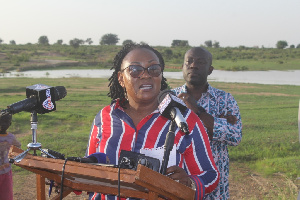The government has completed the construction of 200 small dams under the One village, One dam (1V1D) initiative, the Minister of Special Development Initiatives, Ms Mavis Hawa Koomson, has announced.
She said 570 dams would be constructed across the five regions of the north, as work on more than 100 dams was progressing steadily.
Speaking at the Results Fair in Accra yesterday, Ms Koomson said the beneficiary communities had started reaping the benefits of the dams as the water is used for domestic chores and farming, and herdsmen no longer walk long distances in search of water.
The minister backed her claims with video documentaries of officials of the ministry’s recent visit to some of the communities, showing farmers cultivating and harvesting vegetables and other food crops in the vicinity of the dams, which she said were used as sources of irrigation.
Ms Koomson explained that hitherto in the dry season, most agricultural activities came to a halt in the northern part of the country due to drought and herdsmen had to walk their animals miles away to access water.
The situation, she said, had changed with the introduction of the small dams and the government had not regretted the initiative.
Delivered promise
Ms Koomson explained that what the government promised was “an interventional village earth dams” and those were exactly what are being constructed, saying “we’re happy to see the dams produce the desired results.”
She said the 1V1D initiative sought to ensure an all-year-round availability of water for farming and livestock rearing for smallholder farmers and that the initiative was a product of strong collaboration between the ministry and the Northern Development Authority, the Ghana Irrigation Development Authority and the Ministry of Food and Agriculture.
Specifications
“Our monitoring reports have shown that so far all the small earth dams are being constructed according to the specifications and the design of each dam comes with a specification depending on the nature or topography of the land on which the dam is being constructed,” she explained.
Ms Koomson further said each of the dams occupied a land of about two hectares, had an earth embankment wall with a maximum height of about five metres and a width of four metres wide.
They also had a water depth of about five metres and an embankment wall ranging between 250 and 350 metres long.
The minister added that the dams also had spillways to expel excess water and were estimated to have carrying capacity of over 30,000 cubic metres of water, enough to survive the dry season.
Other projects under IPEP
Ms Koomson said the government was also carrying out over 3,000 priority projects under its initiative, Infrastructure for Poverty Eradication Programme (IPEP).
She explained that two approaches were being used in the delivery of the programme, namely the top-down approach, which constituted government priority projects such as the One constituency, One ambulance programme.
Other projects under the top-down approach included 1,000 community-based water systems and 50,000-tonne capacity warehouses.
She said the other approach was the bottom-up approach, constituting community demanded infrastructure delivered based on needs assessment.
Those projects included markets, refurbishment of school blocks and provision of boreholes among many others, Ms Koomson stated.
 Home Of Ghana News Ghana News, Entertainment And More
Home Of Ghana News Ghana News, Entertainment And More





